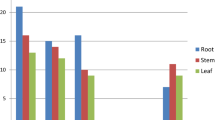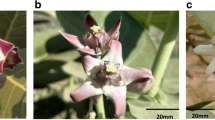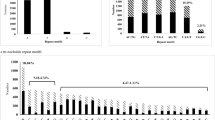Abstract
In this study, we report results of the detection and analysis of SSR markers derived of cacao–Moniliophthora perniciosa expressed sequence tags (ESTs) in relation to cacao resistance to witches’ broom disease (WBD), and we compare the polymorphism of those ESTs (EST-simple sequence repeat (SSR)) with classical neutral SSR markers. A total of 3,487 ESTs was used in this investigation. SSRs were identified in 430 sequences: 277 from the resistant genotype TSH 1188 and 153 from the susceptible one Catongo, totalizing 505 EST-SSRs with three types of motifs: dinucleotides (72.1%), trinucleotides (27.3%), and tetranucleotides (0.6%). EST-SSRs were classified into 16 main categories; most of the EST-SSRs belonged to “Unknown function” and “No homology” categories (45.82%). A high frequency of SSRs was found in the 5’UTR and in the ORF (about 27%) and a low frequency was observed in the 3’UTR (about 8%). Forty-nine EST-SSR primers were designed and evaluated in 21 cacao accessions, 12 revealed polymorphism, having 47 alleles in total, with an average of 3.92 alleles per locus. On the other hand, the 11 genomic SSR markers revealed a total of 47 alleles, with an average of 5.22 alleles per locus. The association of EST-SSR with the genomic SSR enhanced the analysis of genetic distance among the genotypes. Among the 12 polymorphic EST-SSR markers, two were mapped on the F2 Sca 6 × ICS 1 population reference for WBD resistance.





Similar content being viewed by others
Abbreviations
- AFLP:
-
Amplified fragment length polymorphism
- EST:
-
Expressed sequence tag
- HWE:
-
Hardy–Weinberg equilibrium
- LD:
-
Linkage disequilibrium
- LG:
-
Linkage group
- MAS:
-
Marker-assisted selection
- ORF:
-
Open reading frame
- PCA:
-
Principal component analysis
- PIC:
-
Polymorphic information content
- QTL:
-
Quantitative trait locus
- RAPD:
-
Random amplified polymorphic DNA
- RFLP:
-
Restriction fragment length polymorphism
- Sca 6:
-
Scavina 6
- SD:
-
Standard deviation
- SNP:
-
Single nucleotide polymorphism
- SSR:
-
Simple sequence repeats
- TSH:
-
Trinidad selected hybrid
- UTR:
-
Untranslated region, WBD, witches’ broom disease
- WBD:
-
Witches’ broom disease
References
Aggarwal RK, Hendre PS, Varshney RK, Bhat PR, Krishnakumar V, Singh L (2007) Identification, characterization and utilization of EST-derived genic microsatellites for genome analyses of coffee and related species. Theor Appl Genet 114:359–372
Aime MC, Phillips-Mora W (2005) The causal agents of witches’ broom and frosty pod rot of cacao (chocolate, Theobroma cacao) form a new lineage of Marasmiaceae. Mycologia 97:1012–1022
Albuquerque PSB (2006) Mapas de ligação e Identificação de locos controladores de características quantitativas (QTLs) associados à resistência a Crinipellis perniciosa em acessos de cacaueiro (Theobroma cacao) originários da Amazônia Brasileira. Tese (Doutorado em Agronomia)–Escola Superior de Agricultura Luis de Queiroz. Universidade de São Paulo, Piracicaba, p 133
Anderson JA, Churchill GA, Sutrique JE, Tanksley SD, Sorrells ME (1993) Optimizing parental selection for genetic linkage maps. Genome 36:181–186
Argout X, Fouet O, Wincker P, Gramacho K, Legavre T, Sabau X, Risterucci AM, Da Silva C, Cascardo J, Allegre M, Kuhn D, Verica JA, Courtois B, Loor RG, Regis B, Sounigo O, Ducamp M, Guiltinan MJ, Ruiz M, Alemanno L, Machado R, Phillips W, Schnell R, Gilmour M, Rosenquist E, Butler D, Maximova S, Lanaud C (2008) Towards the understanding of the cocoa transcriptome: production and analysis of an exhaustive dataset of ESTs of Theobroma cacao generated from various tissues and under various conditions. BMC Genomics 30:512
Belkhir K, Borsa P, Chikhi L, Raufaste N, Bonhomme F (1999) GENETIX 4.04, logiciel sous Windows TM pour la génétique des populations. Laboratoire Génome, Populations, Interactions, CNRS UMR 5000, Université de Montpellier II, Montpellier, France.
Borrone JW, Meerow AW, Kuhn DN, Whitlock BA, Schnell RJ (2007) The potential of the WRKY gene family for phylogenetic reconstruction: an example from the Malvaceae. Mol Phylogenet Evol 44:1141–1154
Borrone JW, Kuhn DN, Schnell RJ (2004) Isolation, characterization, and development of WRKY genes as useful genetic markers in Theobroma cacao. Theor Appl Genet 109:495–507
Cheong YH, Chang H, Gupta R, Wang X, Zhu T, Luan S (2002) Transcriptional profiling reveals novel interactions between wounding, pathogen, abiotic stress, and hormonal responses in Arabidopsis1. Plant Physiol 129:661–677
Cho YG, Ishii T, Temnykh S, Chen X, Lipovich L, McCouch SR, Park WD, Ayres N, Cartinhour S (2000) Diversity of microsatellites derived from genomic licraries and GenBank sequences in rice (Oryza sativa L.). Theor Appl Genet 100:713–722
Clement D, Risterucci AM, Motamayor JC, N’Goran JAK, Lanaud C (2003) Mapping quantitative trait loci for bean traits and ovule number in Theobroma cacao L. Genome 46:103–111
Coram TE, Pang ECK (2005) Isolation and analysis of candidate ascochyta blight defence genes in chickpea. Part II. Microarray expression analysis of putative defence-related ESTs. Physiol Mol Plant Pathol 66:201–210
Corpet F, Servant F, Gouzy J, Kahn D (2000) ProDom and ProDom-CG: tools for protein domain analysis and whole genome comparisons. Nucleic Acids Res 28:267–269
Creste S, Tulmann Neto A, Figueira F (2001) Detection of single sequence repeat polymorphisms in denaturing polyacrylamide sequencing gels by silver staining. Plant Mol Biol Report 19:299–306
Cupertino FB (2007) Marcadores microssatélites como ferramentas úteis para estimação de diversidade genética e certificação de paternidade em híbridos de Eucalyptus spp. Master thesis, Universidade Estadual de Santa Cruz, UESC, Ilhéus-BA, Brazil
Doyle JJ, Doyle JL (1990) Isolation of plant DNA from fresh tissue. Focus 12:13–15
Eujayl I, Sorrells M, Baum M, Wolters P, Powell W (2001) Assessment of genotypic variation among cultivated durum wheat based on EST-SSRs and genomic SSRs. Euphytica 119:39–43
Ewing B, Hillier L, Wendl M, Green P (1998) Base-calling of automated sequencer traces using phred. I. Accuracy assessment. Genome Res 8:175–185
Faleiro FG, Queiroz VT, Lopes UV, Guimarães CT, Pires JL, Yamada MM, Araújo IS, Pereira MG, Schnell R, Souza Filho GA, Ferreira CF, Barros EG, Moreira MA (2006) Mapping QTLs for Witches’ Broom (Crinipellis perniciosa) Resistance in cacao (Theobroma cacao L.). Euphytica 149:227–235
Feingold S, Lloyd J, Norero N, Bonierbale M, Lorenzen J (2005) Mapping and characterization of new EST-derived microsatellites for potato (Solanum tuberosum L.). Theor Appl Genet 111:456–466
Flament MH, Kebe I, Clement D, Pieretti I, Risterucci AM, N’Goran JAK, Cilas C, Despréaux D, Lanaud C (2001) Genetic mapping of resistance factors to Phytophtora palmivora in cocoa. Genome 44:79–85
Fraser LG, Harvey CF, Crowhurst RN, De Silva HN (2004) EST-derived microsatellites from Actinidia species and their potential for mapping. Theor Appl Genet 108:1010–1016
Gesteira AS, Micheli F, Carels N, Da Silva AC, Gramacho KP, Schuster I, Macedo JN, Pereira GAG, Cascardo JCM (2007) Comparative analysis of expressed genes from cacao meristems infected by Moniliophthora perniciosa. Annals of Botany doi:10.1093/aob/mcm092
Goudet J (2002) FSTAT: a program to estimate and test gene diversities and fixation indices (version 2.9.3.2). University of Lausanne, Department of Ecology & Evolution, Lausanne
Gupta PK, Varshney RK (2000) The development and use of microsatellite markers for genetic analysis and plant breeding with emphasis on bread wheat. Euphytica 113:163–185
Han Z, Wang C, Song X, Guo W, Gou J, Li C, Chen X, Zhang T (2006) Characteristics, development and mapping of Gossypium hirsutum derived EST-SSRs in allotetraploid cotton. Theor Appl Genet 112:30–439
Harris MA, Clark J, Ireland A, Lomax J, Ashburner M, Foulger R, Eilbeck K, Lewis S, Marshall B, Mungall C, Richter J, Rubin GM, Blake JA, Bult C, Dolan M, Drabkin H, Eppig JT, Hill DP, Ni L, Ringwald M, Balakrishnan R, Cherry JM, Christie KR, Costanzo MC, Dwight SS, Engel S, Fisk DG, Hirschman JE, Hong EL, Nash RS, Sethuraman A, Theesfeld CL, Botstein D, Dolinski K, Feierbach B, Berardini T, Mundodi S, Rhee SY, Apweiler R, Barrell D, Camon E, Dimmer E, Lee V, Chisholm R, Gaudet P, Kibbe W, Kishore R, Schwarz EM, Sternberg P, Gwinn M, Hannick L, Wortman J, Berriman M, Wood V, de la Cruz N, Tonellato P, Jaiswal P, Seigfried T, White R (2004) Gene Ontology Consortium. The Gene Ontology (GO) database and informatics resource. Nucleic Acids Res 32:258–261
Huang X, Madan A (1999) CAP3: a DNA sequence assembly program. Genome Res 9:868–877
Jones PG, Allaway D, Gilmour DM, Harris C, Rankin D, Retzel ER, Jones CA (2002) Gene discovery and microarray analysis of cacao (Theobroma cacao L.) varieties. Planta 216:255–264
Journet E-P, van Tuinen D, Gouzy J, Crespeau H, Carreau V, Farmer M-J, Niebel A, Schiex T, Jaillon O, Chatagnier O, Godiard L, Micheli F, Kahn D, Gianinazzi-Pearson V, Gamas P (2002) Exploring root symbiotic programs in the model legume Medicago truncatula using EST analysis. Nucleic Acids Res 30:5579–5592
Kantety RV, Rota ML, Matthews DE, Sorrells ME (2002) Data mining for simple sequence repeats in expressed sequence tags from barley, maize, rice, sorghum and wheat. Plant Mol Biol 48:501–510
Lanaud C, Risterucci AM, Pieretti I, Falque M, Bouet A, Lagoda PJL (1999) Isolation and characterization of microsatellites in Theobroma cacao L. Mol Ecol 8:2141–2152
Leal GA, Albuquerque PSB, Figueira A (2007) Genes differentially expressed in Theobroma cacao associated with resistance to witches’ broom disease caused by Crinipellis perniciosa. Mol Plant Pathol 8:279–292
Liewlaksaneeyanawin C, Ritland CR, El-Kassaby YA, Ritland K (2004) Single-copy, species transferable microsatellites markers developes from loblolly pine. Theor Appl Genet 109:361–369
Lima SL, Gramacho KP, Gesteira AS, Lopes UV, Gaiotto FA, Zaidan HA, Pires JL, Cascardo JCM, Micheli F (2008) Characterization of microsatellites from cacao–Moniliophthora perniciosa interaction expressed sequence tags. Mol Breeding 112:399–406
Luz EDMN, Sgrillo RB, Santos Filho LP (2005) Estimativas de danos e perdas causadas por doenças no cacaueiro. In: Workshop de epidemiologia de doenças de Plantas, 1 Viçosa 2004. Proceedings. Editora UFV, Viçosa, pp 67–79
Morgante M, Hanafey M, Powell W (2002) Microsatellites are preferentially associated with non repetitive DNA in plant genomes. Nat Genet 30:194–200
Motamayor JC, Risterucci AM, Heath M, Lanaud C (2003) Cacao domestication II: progenitor germplasm of the Trinitario cacao cultivar. Heredity 91:322–330
Motamayor JC, Risterucci AM, Lopez PA, Ortiz CF, Moreno A, Lanaud C (2002) Cacao domestication I: the origin of the cacao cultivated by the Mayas. Heredity 89:380–386
N'Goran JAK, Laurent V, Risterucci AM, Lanaud C (1994) Comparative genetic diversity of Theobroma cacao L. using RFLP and RAPD markers. Heredity 73:589–597
Nicot N, Chiquet V, Gandon B, Amilhat L, Legeai F, Leroy P, Bernard M, Sourdille P (2004) Study of simple sequence repeat (SSR) markers from wheat expressed sequence tags (ESTs). Theor Appl Genet 109:800–805
Paim VRLM, Luz EDMN, Pires JL, Silva, SDVM, Souza JTS, Bevilaqua A, Santos Filho LP (2006) Sources of resistance to Crinipellis perniciosa in progenies of cacao accessions collected in the Brazilian Amazon. Scientia. Agrícola 63:572-578
Pires JL (2003) Avaliação quantitativa e molecular de germoplasma para o melhoramento do cacaueiro com ênfase na produtividade, qualidade de frutos e resistência a doenças. Tese (Doutorado em Genética e Melhoramento). Universidade Federal de Viçosa, p 328
Pound FJ (1938) Cocoa and witches’ broom disease (Maramius pernicious) of South America with notes on other species of Theobroma. Cocoa Res 1:20–72
Pound FJ (1943) Cocoa and witches’ broom disease: report on a recent visit to the Amazon territory of Peru. In: Toxopeus H (ed) The archive of cocoa research, vol 1. ACRI- IOCC, London, United Kingdom
Pugh T, Fouet O, Risterucci AM, Brottier P, Abouladze M, Deletrez C, Courtois B, Clement D, Larmande P, N’Goran JAK, Lanaud C (2004) A new cacao linkage map based on codominant markers: development and integration of 201 new microsatellite markers. Theor Appl Genet 108:1151–1161
Rios-Ruiz RA (2001) Melhoramento para resistência a doenças. In: Dias L.A.S. (ed.), Melhoramento genético do cacaueiro. Funape-UFG, Editora Folha de Viçosa Ltda, p 289–324
Romeis T, Piedras P, Zhang S, Klessig DF, Hirt H, Jones JDG (1999) Rapid Avr9- and Cf-9–dependent activation of MAP kinases in tobacco cell cultures and leaves: convergence of resistance gene, elicitor, wound, and salicylate responses. Plant Cell 11:273–287
Rungis D, Berube Y, Zhang J, Ralph S, Ritland CE, Ellis BE, Douglas C, Bohlmann J, Ritland K (2004) Robust simple sequence repeat markers for spruce (Picea spp.) from expressed sequence tags. Theor Appl Genet 109:1283–1294
Sanwen H, Baoxi Z, Milbourne D, Cardle L, Guimei Y, Jiazhen G (2000) Development of pepper SSR markers from sequence databases. Euphytica 117:163–167
SAS Institute INC (1988) SAS/STAT User’s Guide. Release 6.03. SAS Institute Inc, Cary, NC, p 1028
Smart CC, Fleming AJ (1996) Hormonal and environmental regulation of a plant PDR5-like ABC transporter. Am Soc Biochem Mol Biol 271:19351–19357
Trevizan SDP, Da Silva MF Jr (1995) Impactos sociais, econômicos e ambientais relacionados a vassoura-de-bruxa. Congresso Brasileiro de Economia e Sociologia Rural, vol 33. Anais, Curitiba, PR, p 1409
Van Ooijen JW (2006) JoinMap 4, Software for the calculation of genetic linkage maps in experimental populations. Kyazma BV, Wageningen, Netherlands
Varshney RK, Graner A, Sorrells ME (2005) Genic microsatellite markers in plants: features and applications. Trends Biotech 23:48–55
Verica JA, Maximova SN, Strem MD, Carlson JE, Bailey BA, Guiltinan MJ (2004) Isolation of ESTs from cacao (Theobroma cacao L.) leaves treated with inducers of the defense response. Plant Cell Report 23:404–413
Zaidan HA, Gesteira A, Micheli FFL, Ceita GO, Cascardo J, Carels N, Braz NG, Serra WO, Gramacho KP, Lopes UV (2005) Caracterizaçao molecular da resistência do cacaueiro (Theobroma cacao L.) a vassoura de bruxa. In: XXXVIII Congresso Brasileiro de Fitopatologia, Brasília, Brasil
Acknowledgments
The present study was carried out in the Molecular Plant Pathology Laboratory (FITOMOL) of the Cocoa Research Center, Bahia, Brazil. This paper is part of an effort for searching novel genes to WBD resistance, coordinated by José Luis Pires and Karina Peres Gramacho at CEPEC/CEPLAC, and is funded by the Brazilian agency of Bahia–FAPESB (FAPESB; research grant no. APR160/2007) and for providing a research fellowship to N. Carels. This research was also supported by the Conselho Nacional de Desenvolvimento Científico e Tecnológico (CNPq; research grant no. 471274/2006-2 and the Ministère des Affaires Etrangères Français (MAE). LSL (Doctor Student) was granted by the Brazilian agency of Bahia–FAPESB.
Author information
Authors and Affiliations
Corresponding author
Additional information
Communicated by J. Davis
Electronic supplementary material
Below is the link to the electronic supplementary material.
Rights and permissions
About this article
Cite this article
Lima, L.S., Gramacho, K.P., Pires, J.L. et al. Development, characterization, validation, and mapping of SSRs derived from Theobroma cacao L.–Moniliophthora perniciosa interaction ESTs. Tree Genetics & Genomes 6, 663–676 (2010). https://doi.org/10.1007/s11295-010-0282-1
Received:
Revised:
Accepted:
Published:
Issue Date:
DOI: https://doi.org/10.1007/s11295-010-0282-1




